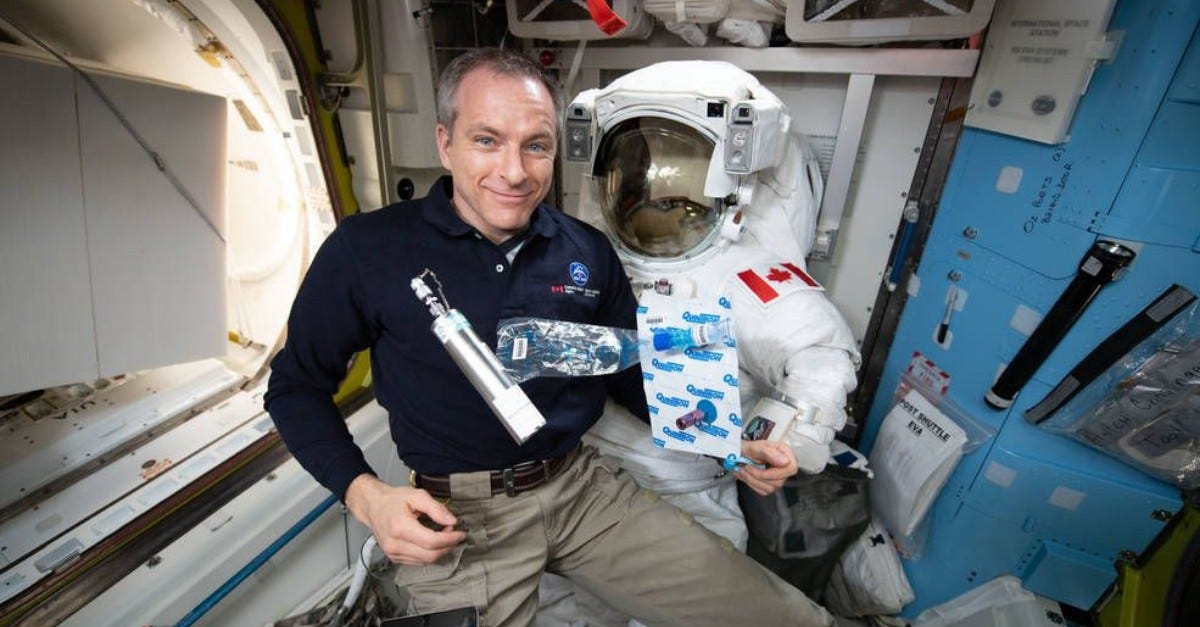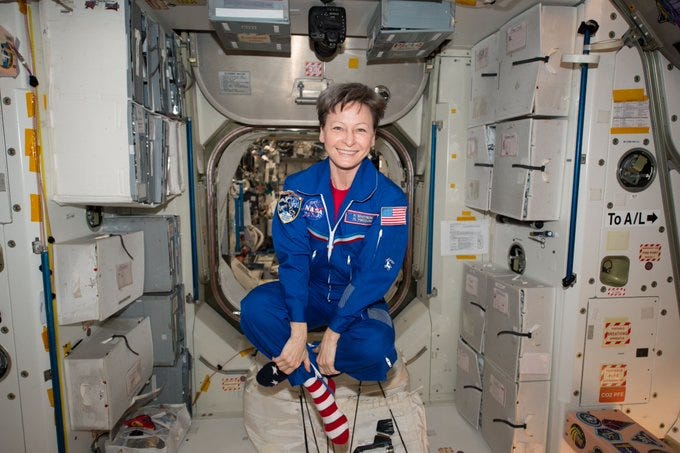
Thanks for finding Full Throttle. The newsletter will be delivered twice a week for free once you subscribe here. Follow me on Twitter, Instagram, and Linkedin. Note: This story includes a journalist in a Soyuz mock-up. A career highlight!
Did you see the news last week? Another malady that spacefarers will have to contend with during long duration missions. We can add it to the growing long list of spaceflight health conditions. Despite the risks, the lure of space remains strong for America’s astronauts.
An astronaut’s day on the International Space Station (ISS) is filled with scientific experiments. The astronauts are laboratory technicians zooming around the earth at 17,500 mph. They study how microgravity affects on everything from metallurgy to botany.

NASA astronaut Chris Cassidy performs an ultrasound on European Space Agency astronaut Luca Parmitano for the Spinal Ultrasound investigation. (Credit: NASA)
The astronauts are also guinea pigs.They poke and prod each other to learn the effects of space on the human body. The zero-g environment completely changes the way fluids are distributed in our bodies, causing all kinds of havoc. Of course, without the protection of the atmosphere, radiation is bombarding their bodies.

NASA astronaut Karen Nyberg of NASA uses a fundoscope to image her eye while in orbit. (Credit: NASA)
The latest study shatters our understanding of how an astronaut’s blood changes while in space. Published last week in Nature Medicine, the researchers found that space kills off red blood cells the entire time an astronaut is in space at a rate 54% higher than on earth.
Medical experts long believed that after 10 days in space an astronaut’s body would return to normal red blood cell rotation (our bodies create and shed these blood cells every second). The team at the University of Ottawa found several astronauts return to earth anemic and it takes a long time to get back to normal.

Dr. David St-Jacques showing the materials he used to collect air samples for the study on red blood cell loss in astronauts. (Credit: Canadian Space AgencyNASA)
“Our study shows that upon arriving in space, more red blood cells are destroyed, and this continues for the entire duration of the astronaut’s mission,” lead researcher Dr. Guy Trudel says. Suffering from a lower red blood cell count means that, “when landing on Earth and potentially on other planets or moons, anemia affecting your energy, endurance, and strength can threaten mission objectives,” Dr. Trudel added in a University of Ottawa release.This was a five-year study involving 14 astronauts who spent about six months on the ISS.
While this is the newest study, NASA is deeply involved in using the ISS to learn how astronauts will fare on the moon and beyond. The studies are expansive, as are the challenges to keep humans in space for long periods of time.
A look at the NASA twins study involving astronauts Scott and Mark Kelly. (Credit: ABC News)
NASA has been extending the missions of some astronauts who are providing this critical data. Records continue to be shattered. Scott Kelly surrendered his record. Peggy Whitson (289 days) is close to losing her record to Mark Vande Hei, on ISS right now, who may spend 355 days in space.

NASA astronaut Mark Vande Hei conducts operations for space agriculture experiment that is studying cotton genetics in January 2022. (Credit: NASA)
The health issues range from changes in eyesight from fluids pushing on the cranium, to loss of bone density, and even more inhalation of dust particles. The research conducted by NASA is extensive and, as this new study shows, they learn more every trip. I asked Scott Kelly (many thanks to Scott for getting me in the Soyuz and ISS trainers) and his fellow astronaut, twin brother Mark, whether long duration space missions, “can mess you up.” Both brothers said it is a risk worth taking.

Astronaut Peggy Whitson on ISS in a photo she posted to Twitter.
Peggy Whitson is an example of the desire to get back to space despite those risks. Whitson retired from NASA a few years ago. The reason? She would never fly again because she had hit the NASA-imposed radiation limit. “So not going into space with NASA anymore,” she told Business Insider.
Whitson wanted back in the game. Last summer she joined the private space company Axiom and will command the company’s second mission on a SpaceX Dragon Capsule to the ISS.
Astronaut Anne McClain talking about one of the experiments she conducted during her mission to ISS. (Credit: NASA)
As the new study shows, we continue to learn about new health issues for astronauts. That provides data to allow researchers to look for solutions. The risks are high, as are the rewards, if you listen to those who fly to space.
Credit cover photo: Astronaut Andrew Feustel reenters the space station after completing a spacewalk on May 22, 2011.




